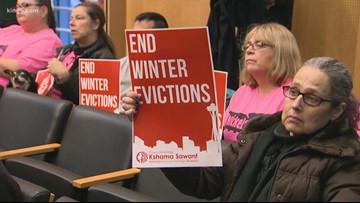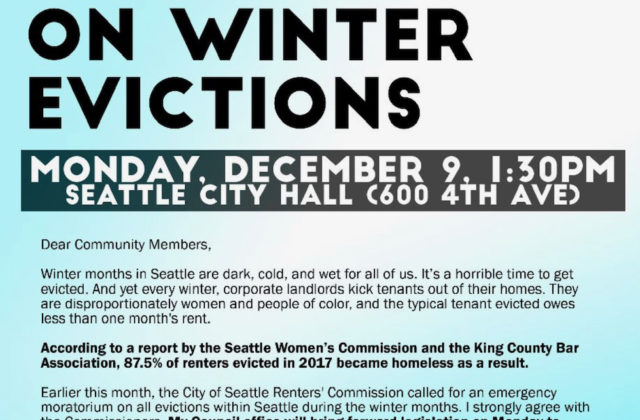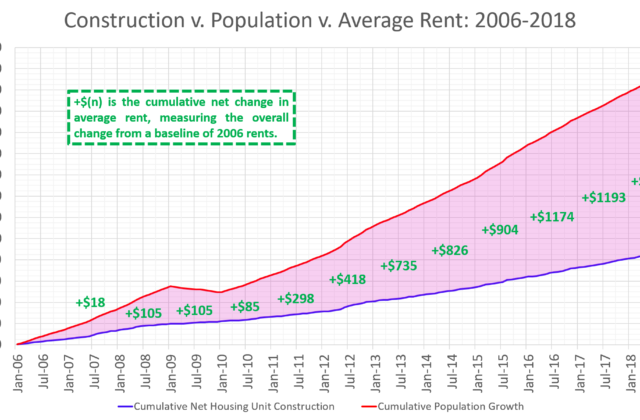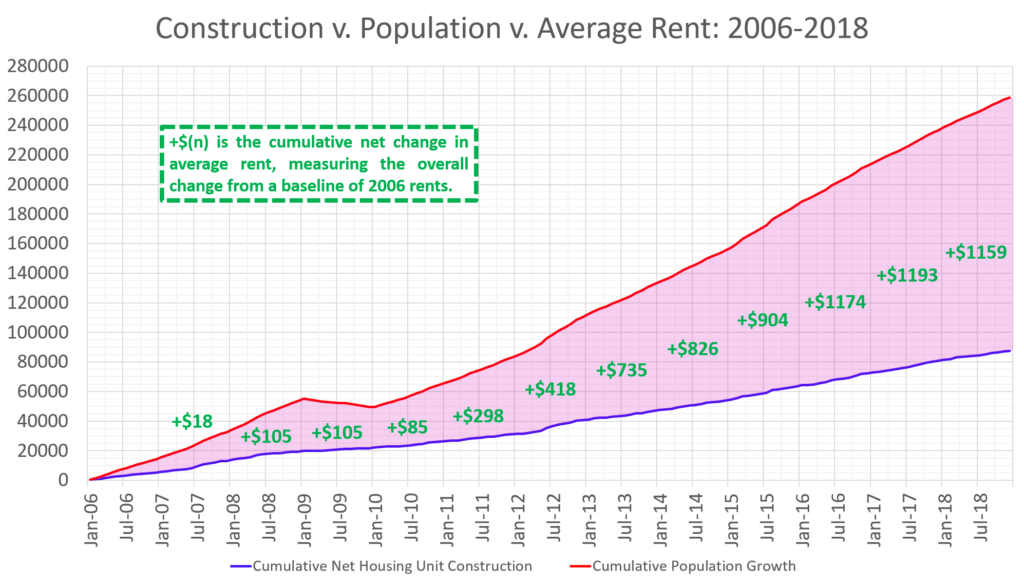Thoughts on 2019 and 2020: What’s Next is Up to You
I had written a longer post on this topic but it disappeared. Maybe that’s a good thing since that post expressed a lot of frustration with where we’ve been in not just the last year but the last six years. So here’s another try and we’ll see if the hacker or internet gods let this one through. Mostly, after thinking about it, we should have learned what not to do, and have a better sense of our best options ahead to improve the environment for people who finance, develop, build, and operate housing in this city, state, and country.
Big Partnerships and Coalitions Won’t Save Us
The Chamber of Commerce and People for Seattle and Amazon all tried and failed disastrously to change the course of elections in 2019. It didn’t work because they didn’t really vet candidates or better yet recruit candidates that had a strong understanding of how market economics works. The field of candidates was weak and unprincipled when it came to supporting what people call, euphemistically, business friendly policies. We need candidates that not only believe in the market as a place of innovation and exchange but who can explain why they believe that to voters.
Too often, the business community, whether in the form of the Chamber, the Grand Bargain, or People for Seattle, doesn’t truly stand up for people in the real estate business or for the idea of a healthy housing market with lots of production to keep up with demand. Usually, what happens is some effort to support “nice people” like Egan Orion. Orion’s biggest selling point was that he was not Kshama Sawant, but he hadn’t a clue about how housing works and actually supported rent control.
Worse, when it came to the Grand Bargain, the “bargain” that gave us fees for new housing in the form of Mandatory Housing Affordability (MHA), when business gets involved we end up with what I have called a bribery scheme where in order to be perceived as “good corporate citizens,” housing development is forced to pay cash into the bank accounts of non-profts. All this does is stoke housing inflation by slowing supply and passing on the costs of fees in the form of higher prices and rent.
Money with no principles behind it funding candidates that have no idea how housing works leads to bad outcomes not just when they lose but also if they win. In the case of Orion, Sawant and her colleagues are now emboldened to do even more damage with an eviction ban, impact fees, and a tax on jobs.
Voter Disposition is Unchanged
We’ve done nothing to mover voter attitudes. Throwing money at these candidates in 2019 actually affirmed the notion that developers and business in general have lots of money to throw around to fool people. I’m not so sure that that perception is wrong in fact. No effort has been made to persuade people that “We don’t need more housing, we need more housing so that it is affordable.” This shift is critical because without it the general sense is we need more and more and more money and even more rules.
Unless we spend real time and money to shift voter attitudes away from reprisals and revenge on people who produce and operate housing, we’re not going to get better candidates. Doing this won’t be easy, but it is a better long term investment that the money we saw spent on elections this year and in 2017.
A Path for 2020 and Beyond
There is a movement gathering around a voter initiative for rent control. The theory is that next session (which begins in days) will not produce a rent control measure. Instead, the thinking is, the advocates will put a measure on the ballot. The effort should therefore be on “winning” that campaign in November of 2020.
There are many problems with this premise. First, progressive and left leaning voters will be out in force to vote against Donald Trump. Trying to oppose a rent control measure in that environment will be next to impossible.
So why not join forces with progressive and left leaning interests that also oppose rent control to create doubt in voters on the left and kill the ballot measure? There are two reasons this will fail.
First, there will be a price, a big price, to be paid by people in the business of housing to get this deal. In some ways, it could dwarf the impact of the MHA in Seattle. The demand will be that in order to get opposition of rent control on the ballot, real estate and business interests will need to support more tax dollars and yes, fees, from developers for non-profit affordable housing.
Second, messages from non-profits and other so called, “White Hats” are unlikely to fool voters. Remember what happened with Egan Orion? People figured out that even though that Orion kid was sweet, he was backed by business. Trying to fool voters is a bad idea. I worked on a campaign in 1993 to oppose two anti-tax initiatives I-601 and 602. We tried to tie them together; the voters passed 601 and voted down 602. The effort failed because in spite of our efforts to confound them, voters saw the difference.
Our current system of over-regulating housing production, watching prices “skyrocket,” then imposing more fees, fines, taxes, and rules on the production of housing to fuel non-profit subsidies will only be reenforced by shoving more cash into the pockets of non-profits. They won’t stop demanding more and more, because the very measures that filled their pockets will make building their product even more challenging and make their waiting lists longer.
The Best Data, Good Ideas, and Telling a Better Story
How do we turn this around? I’ve been saying it all year. We need a War Room of sorts to push back on the sloppy reporting and rhetoric going on all over our city, state and country about housing. No, there is no “eviction epidemic.”
Second, we need to push for ideas that are both efficient and compassionate, like buying down cost burden with cash, not massive and inefficient investment in non-profit housing.
Third, we need to connect with voters, not try to fool them. People in our communities are smart, often wrong, but still smart. Today, they think that when sidewalks get built in a new development, for example, that they pay for those with taxes. That’s just wrong. What if we told them that? Would that change their mind about who pays for growth? That’s just one example of the kinds of conversations we need to have with real people.
It’s Up to You
I’ve made the pitch for your support over and over again. You can do nothing and hope this doesn’t impact you. You can get involved and pitch in on creating a policy center to change our course. Or you can tell us what you think we should do.
I think the worst thing to do is to invest in efforts that will fail and make everything worse.
As Bluto said in Animal House, this ain’t over until you say it’s over! This could be the greatest year ever!
Can You Believe It? It’s Here. It’s Happening, a Ban on Evictions.
I’m not sure what will wake up Seattle’s sleeping business and real estate community. Maybe the slumbering giant isn’t asleep; maybe it’s dead. But perhaps the move by the Seattle City Council to ban evictions 5 months out of the year could raise the dead. To the general public, this idea of not “kicking people out” during winter might make sense and seem compassionate; it isn’t. I explain why on one of 4 television interviews I did a week ago.
It’s time to fight back. The number of people evicted is small and certainly manageable if the City Council is truly motivated by compassion. There may be a dozen or so people a month evicted that face homelessness. We know their names, addresses, and phone numbers. We know the status of their eviction. All of these things are part of the records of the proceeding in eviction court.
Of course, we know that isn’t what the City Council is trying to do. The rudderless body is blown about by whatever mob Councilmember Sawant can conjure; it’s as if the Seattle City Council lives in a little snow globe filled with socialists. Former City Attorney used to call Seattle 85 square miles surrounded by reality. Today, it’s more like one city block surrounded by reality.
If you haven’t already, sign the letter now and make a donation.
You can get to the letter here.
Seattle Eviction Ban: Not Compassionate, Not Needed, Not Legal
Update: You can send a message to council about this here.
The eviction myth persists. Now it forms that basis of a demand that evictions be banned during “winter months.” It starts with garbage data. The claim is that (see the featured image) that,
87.5 of renters evicted in 2017 became homeless as a result [of eviction].
This is nonsense. Where did that number come from? On page 3 of the Losing Home “report” issued by the City’s Women’s Commission and the King County Bar Association earlier this year, there is this paragraph.
Most evicted respondents became homeless, with 37.5% completely unsheltered, 25.0% living in a shelter or transitional housing, and 25.0% staying with family or friends. Only 12.5% of evicted respondents found another apartment or home to move into.
You can see if you add those percentages up, you get 87.5 percent. First, the claim that “most evicted respondents” is one of those sleights of hand that hides the truth in plain sight. Who were the respondents? Were they the 558 people actually removed from units in 2017? No, those weren’t the respondents. There was a separate survey conducted of a completely different set of people, apparently many who were in shelters.
The claim in the Losing Home document is dishonest, giving the impression that some kind of statistically valid study of a representative sample of people evicted found that almost all of them wound up homeless. That’s just false. We have absolutely no idea what happened to the people removed in 2017 the period the Losing Home study makes claims about; nobody collects that data.
Here’s the letter we sent to the Council and anyone else who’ll read it.
—————-
November 25, 2019
Greetings,
Seattle For Growth is a non-profit organization that supports more housing of all kinds in all neighborhoods for people of all levels of income.
Recently the Renter’s Commission (Commission) sent a letter to City officials asking for a moratorium on evictions in Seattle during the winter months. They have based their request on “La Trêve hivernale” or “Winter Truce” in France.
While this request by the Commission presents itself as compassionate, it is unnecessary. Let’s look at some facts. First, landlords want successful tenancies and will seek other options.
It is important to note that very few removals occur in Seattle with only 558 completed in 2017, about 0.3 percent of the 168,000 rental properties in the City; about a third of the removals were completed by the Seattle Housing Authority and The Low Income Housing Institute, according to data collected by the City.[1]

In France the law limiting evictions in winter begins November 1 and runs through April 1 and it,
- Does not apply if the person has somewhere to go;
- Does not apply to squatters;
- Allows a deposit can be required and used to pay rent; and
- Lost rent insurance is available and used in France to cover lost rent, a cost likely passed to all renters.[2]
While some public housing authorities in cities with harsh winters like Chicago do limit removals during this period, no jurisdiction has mandated it for private rentals.[3]
Such a mandate could be a broad violation of the Fifth Amendment to the United States Constitution that provides that nobody be, “deprived of life, liberty, or property, without due process of law; nor shall private property be taken for public use, without just compensation.”
Therefore, if the City feels that it is imperative to implement this policy they could provide and pay for immediate housing for anyone legally removed through the eviction process. The City could also require non-profit housing projects with City funding to suspend removals during a designated period.
Based on the City’s own data from the Losing Home Report cited above, providing $1,000 in housing assistance for 250 evicted households (about half of the total removals in 2017) would cost about $1,250,000 for the 5 month period between November and April.
The cost would likely be less since many households would have alternatives and others would not need assistance for the full period designated.
This kind of program would be compassionate and legal, recognizing that there is already a process in place that requires a court order to remove a person from their housing even if the lease was violated or rent was not paid. That process now includes a longer period to complete thanks to legislative action, supported by the City. [4]
If the City is serious about being compassionate and upholding the law, it might consider this approach.
Sincerely,
Roger Valdez
Director
[1]Valdez, Roger, Losing Perspective: A Response to the Losing Home Report, March 2019
[2]From Droit Fianances website, Trêve hivernale et expulsion – Dates et locataires protégés, November 2019
[3]Pressey, Debra, Housing authority stopping evictions during cold-weather months, The News-Gazette, November 15, 2019
[4]Engrossed Substitute Senate Bill 5600, Chapter 356, Laws of 2019
Marketing the Market: Seattle’s Housing Shortage
Jordan Crawley is a policy and administrative consultant for entrepreneurs in the Seattle area. He formerly worked for the US Army as an Intelligence Analyst and in the US House of Representatives. He currently works with local campaigns, performing policy and data analysis.
The post-recession boom, beginning in the summer of 2009, brought population increases to Seattle that outpaced housing construction and sent rent soaring. Housing affordability now dominates our political discourse with most suggested resolutions (e.g. slowing market-rate housing construction, hastening subsidized housing construction, and rent control) presume more government intervention and public dollars are the answer. Alternatively, experts argue these interventions likely caused, and perpetuate, our dilemma.
In 1985, King County established an “urban growth boundary” (UGM), limiting eastward development. Washington’s Growth Management Act(1990) expanded King County’s UGM concept as a requirement to the states rapidly growing counties and cities. The prescriptive land use policies of the GMA and UGM established a new goal – channel all new growth into spaces already urbanizing. Since its effective date in 1992, the UGM has remained largely intact, but some flaws have become more apparent with regional population increases. While intending to be “comprehensive”, the GMA’s growth management plans fail to facilitate densification and are generally weak on land use. In fact, since the 1990’s, prescriptive land use policies have repeatedly led to reduced affordability and reduced volume of construction.
Researchers from World Bank, Organization for Economic Co-operation and Development, the United Kingdom, Central and Reserve banks, and universities across the United States (including the University of Washington) argue against prescriptive land use. The common understanding is that prescriptive land use directly causes skyrocketing housing costs, slow permitting to a crawl, and allow inequity to thrive.
From 2006 to 2018, Seattle’s population increased by 170,000 people. During the same time, Seattle’s housing market increased by just 87,000 units. Over thirteen years we built about half the housing necessary to meet demand, resulting in significant and sustained rent increases. During the recession (2008-2009), Seattle’s population was stagnant. Because housing supply kept pace with demand, average rent remained the same. In 2010, when Seattle experienced a net decrease in population, supply drew even closer to demand – rents decreased by $20 per month. However, once Seattle recovered and population began outpacing construction, rents spiked every year. By the thirteenth, rents had increased nearly $1,200 per month – correlating very strongly (0.9728) with the difference in population and housing construction.
Poorly managed housing markets were a major cause in trigger the recession, but a more responsive housing supply would likely have limited price volatility and encouraged labor mobility. Overall, speeding up recovery and lessoning the long-term impacts to come. Jan Brueckner from University of California-Irvine put it this way:
“Well-meaning interventions that cause land use outcomes to diverge substantially from free market outcomes run the risk of generating net social losses. The problem is that the expected benefits from large interventions may be swamped by unanticipated losses, which may be overlooked by government officials with an incomplete understanding of the operation of real estate markets.”
By limiting where we build without significantly changing how we build where we build, and without establishing some offsetting benefits, “well-meaning interventions” like rent controls, taxes on housing and development, and growth boundaries caused our current shortage. This disequilibrium has socially significant consequences. If legislators are dead set on maintaining the UGM and are serious about providing more housing locally and regionally, they must also implement systems that significantly expand growth in urban zones. Through more responsive land use regulation, we can allow development to respond to the market and finally eliminate our current, persistent housing shortage. Seattle is still growing. Rather than harsher regulation, it may be time to step back.
KUOW: Finally, Some Balanced News
Back in the old days, and I mean the 1990s, there was a general approach to getting a story in the press. A campaign or advocacy group would issue a press release, call reporters at the half a dozen or so outlets in town that might cover an issue or an event, and then one would “spin” the writers and reporters. No matter what side of the candidate or issue, everyone “worked” the press to try and get what everyone called then, “a good story.” A big win would be one in which a story, made one side look better than the other. The effort wasn’t always successful or would yield mixed results. What was acceptable was a story that had both sides equally laid out with accurate quotes. The world and the city of Seattle are different now when it comes to press coverage. A recent story at KUOW reminded me of those “old days.”
Before I point to that story, I can’t say whether the situation is better or worse because when it comes to the media, all things are possible with a good strategy. But the example what happens today is a situation earlier this year in which a reporter at the Seattle Times, Jake Goldstein-Street, wrote a story with this headline: Eviction reforms in Olympia get a boost from Seattle tech giants. The day before this story was published in print, I had called the reporter and left a message because I got a hold of the letter supposedly declaring the support of the “tech giants” (the original headline) for the really bad legislation. I also called the Amazon lobbyist locally and in Washington DC to ask them what they thought they were doing.
My calls were all of the same variety; is this letter for real (it was a Word document with no letter head and no actual signatures just names), and would anyone like to hear about why “the report” the bill was based on was bogus before they circulated a letter in support? The reporter never bothered to call back even though he had plenty of time to hear from someone on the other side of the legislation and the report. The next day I talked (some might say yelled) with the reporter.
“Did you call the signers of the letter?” I asked?
“No, I didn’t,” he said.
“Jake, that was bad. You didn’t do your job,” I said. “I have an e-mail from Amazon’s lobbyist saying that they don’t support the legislation, the lawyer who signed it did it on his own, as just a person.”
And I heard from other signers who said the same thing; “the company doesn’t support this, I do.” So the headline and the story was wrong. I called the editor and left him a message. Was there a correction or even an update to the online story with a quote from someone in the business responding to “the report?” Today the story online has “execs” rather than “giants.” But the story is online with all the same imbalance without any coverage of why the underlying argument that evictions are “an epidemic” isn’t true.
The problem in today’s media world may have to do with the speed things move. Goldstein-Street could call people on cell phones, email and text people, put together his story and pull the trigger in minutes. Add to that the fact that in the world of Donald Trump, the press feels under attack or at least justified in sticking to their story and defending their reporters even when they make really bad and provable mistakes. Deadlines come and go, and the next cycle spins up much faster covering over people’s sense of nuance. I doubt most people even read the story so the headline was about all they got. And I might have reversed some of the damage with the legislative committee working on the bill with an email I forwarded from Amazon’s lobbyist confirming they had no position on the bill. The damage in the wider public was done; well, at least Amazon and Microsoft hate landlords too! Finally, the notion that landlords are bad and tenants are downtrodden is just accepted; no need to waste any shoe leather trying to track down whether that is true.
So what does the opposite of the “Tech Giants” story. Well, it’s here at KUOW website with a headline: ‘I feel like I’m the bad guy.’ Seattle landlords grudgingly comply with new tenant law. Wow. I don’t like the word grudgingly because people who already have it out for landlords will find that confirmatory. But the story explains that the new law was challenged and does a great job of explaining why people who rent property feel that it undercuts their ability to help real people, the ones that bad legislation is supposed to help. Wow, again. And I understand after reading what the other side thinks too. Wow. And the reporter, Amy Radil, appears to have left her office to actually talk with people; there is a picture of the tenant advocates with her credit. Now if her colleagues would put the sandwich down, put on their coats, and do the same kind of reporting, maybe we can return to the good old days of the “balanced story.”







